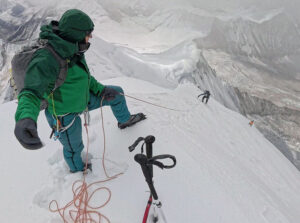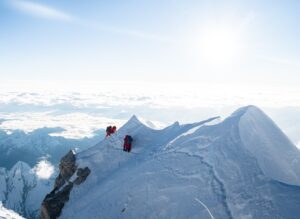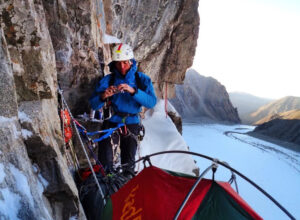Kristin Harila of Norway, 37, and Tenjen Lama Sherpa of Nepal, 35, may or may not write a page of mountaineering history, but they will definitely occupy the first line in a number of statistical tables. Harila and Sherpa — who climbed in a client-guide relationship — tagged the summit of all 14 mountains in the world over 8,000m in just over three months.
In doing so, they beat the previous fastest time — with caveats — of Nimral Purja by three months. As much logistical feat as physical triumph, Harila and Sherpa have set a somewhat strange and difficult to reach benchmark in the world of high-altitude mountaineering. Before Purja accomplished his similar feat in 2019, the previous fastest time anyone had climbed all 14,000-meter peaks was more than seven years.
Here is a summary of her 2023 quest to climb all 14 mountains in the world over 8,000m in record time. It culminated successfully yesterday on K2, after a total of 92 days, or three months and one day. Tenjen Lama Sherpa guided her on all 14 climbs.

Chart: Seven Summit Treks
First leg: Tibet
Kristin Harila’s year started in Tibet when she received a special permit to climb in China. It had been closed to foreign climbers since 2019 when Nirmal Purja got another special permit.
Shishapangma (8,027m): April 26. Harila summited with Tenjen Lama Sherpa. Others reached the top that day, too: Sophie Lavaud, Matias Myklebust, Chhiring Wanchu Sherpa, Ngima Rita Sherpa, and Pemba Tenjin Sherpa. There was also a Chinese expedition on the mountain that day, and Dong Hong Juan became the first woman to reach the true summits of all 14 8,000m peaks.

Kristin Harila on the summit of Cho Oyu. Photo: Kristin Harila/Instagram
Cho Oyu (8,188m): May 3. Since she did 12 of the 8,000m peaks in 2022 — all except the two Tibetan ones — this was the last of the 14 for Harila. From this point, all her future peaks would be repetitions. She summited with Tenjen Lama Sherpa and Ngima Rita Sherpa. This would be her smallest summit team in 2023.
Second Leg: Nepal

Kristin Harila on the summit of Makalu. Photo: Kristin Harila/Facebook
Makalu (8,485m): May 13. In Nepal, Harila used Seven Summit Treks’ effective logistics to hop swiftly by helicopter from Base Camp to Base Camp and follow closely behind the rope-fixing team to the summit. Tenjen Sherpa, Lakpa Sherpa, Chhiring Namgyal Sherpa, Dorchi Sherpa, Angdemba Sherpa, Furtemba Sherpa, Pema Sherpa, and Ang Dawa Sherpa joined her on top.

Kristin Harila’s tracker, showing her summit of Kangchenjunga.
Kangchenjunga (8,586m): May 18. Again following the rope fixers, Harila’s summit push took longer than expected because her group chose the wrong couloir. When they realized this, they had to retrace their steps and climb again to the main summit. Some no-O2 climbers who followed the same false couloir had to abandon their attempt. Harila was assisted by Tenjen Lama Sherpa and Gelu Sherpa, plus the rope-fixing team.
Everest (8,848m) AND Lhotse (8,516m): May 23. Harila broke her own speed record by rushing from the summit of Everest, which she reached at 3:45 am, to the top of Lhotse (passing by Lhotse’s Camp 4) within eight hours. Tenjen Lama Sherpa and an unidentified sherpa team were at her side.

Harila on the summit of Dhaulagiri. Photo: Kristin Harila/Instagram
Little time off
Dhaulagiri: (8,167m): May 29. After Everest/Lhotse, Harila flew to Kathmandu for some rest in a hotel. But less than a week after her double-header, she was airlifted to Dhaulagiri, which she and Tenjen climbed right away in one push. (Seven Summit Treks had previously fixed the ropes to the top.) She had only used 34 days since the beginning of her 2023 race.

Harila and Tenjen holding the Sami ethnical group flag on the summit of Annapurna. Photo: Kristin Harila/Instagram
Annapurna (8,091m): June 5. On Annapurna, she arrived after all the other climbers had left. (As usual, most commercial climbers went earlier in the season.) Seven Summit Treks gave Harila a reinforced support team for the summit push. In addition to Tenjen Sherpa, she climbed with Pasang Nurbu Sherpa, Lakpa Temba Sherpa, Mingma Tenjing Sherpa, Pasang Sherpa, and Lakpa Gyaljen Sherpa. They climbed in one go from Base Camp to Camp 3, then from Camp 3 to the top. She had summited Dhaulagiri less than a week earlier.
Manaslu (8,163m): June 10. This was Harila’s most controversial summit. There were no teams there in spring, and the mountain was not yet fixed or the trail broken by the time her group arrived at Base Camp on June 8. On June 10, Harila, Tenjen Sherpa, Pasang Nurbu Sherpa, Chhangba Sherpa, Kaji Sherpa, Nima Dorchi Sherpa, Sonam Tashi Sherpa stood on the summit. But shortly later, Mingma G (owner of the Nepal-based company Imagine Nepal) denounced Harila’s tactics and poor style. Her sherpa team had used helicopters to get to higher camps and fix the ropes downwards — a much faster way to climb.
3rd Leg: Pakistan
Nanga Parbat (8,125m): June 26. Ensued a two-week break before Harila summited Nanga together with a team outfitted by Seven Summit Treks. Coincidentally, at the summit was Pasdawa Sherpa, one of two Nepali climbers who supported Harila on her 2022 attempt to summit the 14×8,000’ers in six months. Pasdawa, working with 8K Expeditions, topped out with American client Gina Marie Han-Lee and Nawang Sherpa. All the climbers that day used oxygen except for Sajid Sadpara of Pakistan.

Harila and Tenjen on the summit of Gasherbrum II. Photo: Kristin Harila/Facebook
Gasherbrum II (8,034m): July 15. Harila flew to the Gasherbrums’ Base Camp from Skardu. Here, she took a final break before the last push on the Karakoram’s four 8,000’ers. The flight spared her the long, six- to eight-day trek up the Baltoro Valley, but cost her (or her sponsors) $20,000. She climbed the mountain right away.
Gasherbrum I (8,080m): July 18. She climbed with Viridiana Alvarez of Mexico and an eight-member support team that fixed ropes on the upper sections. Denis Urubko and Pipi Cardell had already broken the trail to Camp 2 already. Harila’s home team reported that she summited without oxygen.

Tenjen Lama Sherpa and Kristin Harila on the summit of Broad Peak. Photo: Seven Summit Treks
The quest ends successfully
Broad Peak (8,081m): July 23. Broad Peak was also fast, but not quite fast enough to leave enough time to finish K2 within her self-imposed deadline of three months. Besides Tenjen Sherpa and Harila, the group included Mingtemba Sherpa, Pasang Nurbu Makpa Sherpa, Nima Tashi Sherpa, client Gabriel Tarso of Brazil, and 17-year-old Nima Rinji Sherpa, engaged in his own age/speed record on the 14 peaks. Broad Peak was already his seventh. They reached the top at 4:30 am and made it back to Base Camp that day.

Kristin Harila. Photo: Instagram
K2 (8,611m): July 27. Harila reached K2 Base Camp and climbed right away to Camp 2, as teams prepared for a massive summit push in very uncertain conditions. On July 26 at 8 pm she set off from Camp 3, in heavy snow conditions and with a very short weather window. Ahead a rope-fixing team grappled with loads of unstable snow. Soon after they climbed the Bottleneck and crossed under the Great Serac, two small avalanches fell. One of them killed a Pakistani porter. They nevertheless summited on July 27 at 10:45 am and hustled back to Base Camp that same day.
It had taken her three months and one day to summit all 14 peaks. The previous speed record holder, Nirmal Purja, had taken two years and five-and-a-half months. During his initial six-month achievement, he had only reached the foresummits of two peaks, Manaslu and Dhaulagiri.






